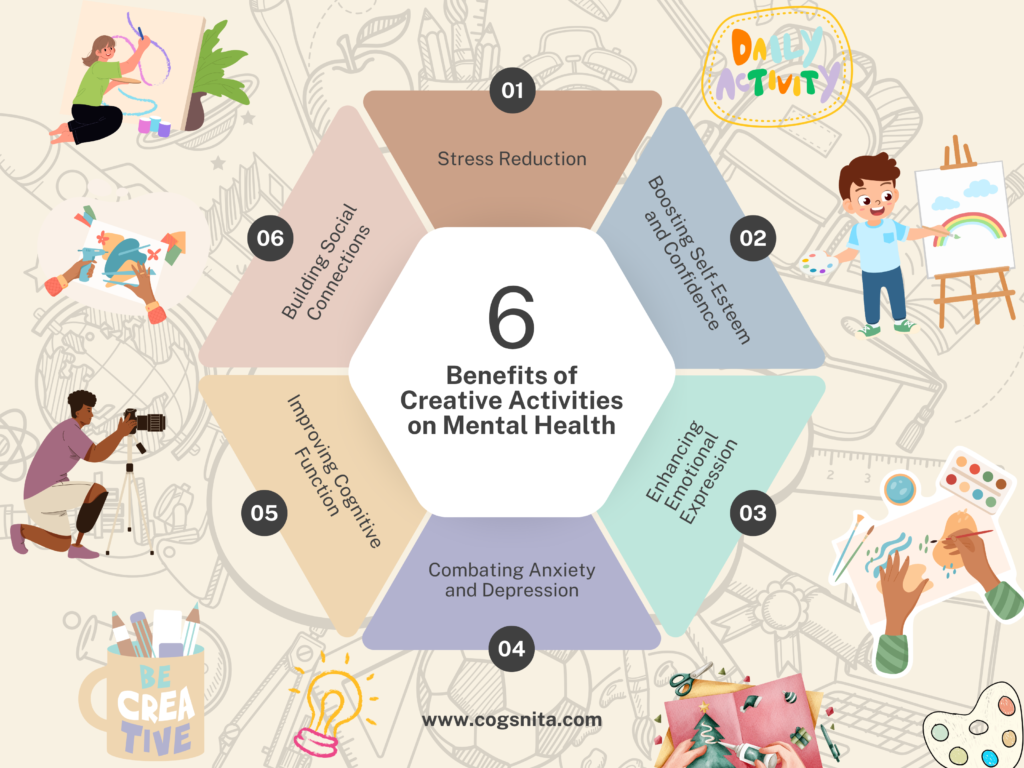Table of Contents
In today’s fast-paced world, mental health challenges are becoming increasingly common. Stress, anxiety, and depression often overshadow our well-being. While traditional therapies and medications play their part, creative activities are emerging as a powerful tool for improving mental health. Activities like painting, writing, crafting, or even cooking not only enhance our emotional well-being but also provide a healthy outlet for expression and stress relief.
Understanding the Connection Between Creativity and Mental Health
Engaging in creative activities stimulates the brain in unique ways. Creativity allows us to process emotions, confront challenges, and find solutions to problems. When we immerse ourselves in such pursuits, our minds enter a state similar to meditation, often referred to as a “flow state.” This state reduces stress hormones like cortisol while promoting the release of dopamine, the feel-good chemical.
Benefits of Creative Activities on Mental Health

- Stress Reduction
Creative activities serve as an escape from the chaos of daily life. Whether it’s sketching, writing poetry, or knitting, focusing on a task shifts our attention away from stressors. This change in focus lowers our heart rate and induces relaxation. - Boosting Self-Esteem and Confidence
Completing a creative project, no matter how small, gives a sense of accomplishment. This boosts self-esteem and builds confidence. For example, finishing a painting or crafting a handmade card can provide immense satisfaction and validation. - Enhancing Emotional Expression
For individuals who struggle to express emotions verbally, creativity offers a safe space to channel feelings. Art therapy, for instance, is widely recognized for helping people process complex emotions and trauma. Writing in a journal or composing a song can also be therapeutic. - Combating Anxiety and Depression
Creative activities can help manage symptoms of anxiety and depression. The repetitive nature of activities like knitting or sculpting provides comfort, while the focus required helps calm racing thoughts. Additionally, these activities promote a sense of purpose and help combat feelings of worthlessness often associated with depression. - Improving Cognitive Function
Creative activities enhance problem-solving skills and improve memory. Activities like playing an instrument or solving puzzles engage multiple brain areas, fostering neural connections that keep the mind sharp and agile. - Building Social Connections
Participating in group creative activities, such as joining a painting class or a book club, provides opportunities to connect with others. Social interactions improve our sense of belonging, which is crucial for mental health.
Types of Creative Activities to Explore
- Visual Arts: Drawing, painting, photography, or digital art
- Writing: Journaling, storytelling, poetry, or blogging
- Performing Arts: Dancing, singing, or acting
- Crafting: Knitting, woodworking, or jewelry making
- Music: Playing instruments, composing, or even listening mindfully
- Culinary Arts: Cooking and baking
Incorporating Creativity into Your Daily Life
- Start Small: Dedicate 10-15 minutes daily to a creative pursuit.
- Experiment: Try different activities until you find one that resonates with you.
- Create a Dedicated Space: Set up a space where you can comfortably engage in creative activities.
- Join a Community: Engage with like-minded individuals to stay inspired and motivated.
Real-Life Stories of Creativity Transforming Mental Health
Take Sarah, for example, who began painting as a hobby during a difficult phase in her life. Over time, her anxiety levels decreased, and she started viewing challenges from a new perspective. Similarly, Michael, who struggled with depression, found solace in writing poetry, allowing him to process his emotions and connect with others through his work.
Conclusion
Creative activities are more than just hobbies; they are lifelines for mental health. By engaging in such pursuits, you can reduce stress, build confidence, and foster emotional resilience. The key is to find an activity that resonates with you and make it a part of your routine.
Incorporating creativity into your life doesn’t require artistic talent or expensive tools—just a willingness to explore. So, pick up that brush, start journaling, or join a local dance class. Your mind and soul will thank you for it.
Resources
- How to Get Started with Art Therapy
- 12 Creative Activities to Boost Mental Health
- Cogsnita: Gamification in Cognitive Training: Does It Work?
This blog post aims to inspire you to embrace creativity as a tool for mental well-being. Dive into your chosen activity and experience the transformation it brings!
